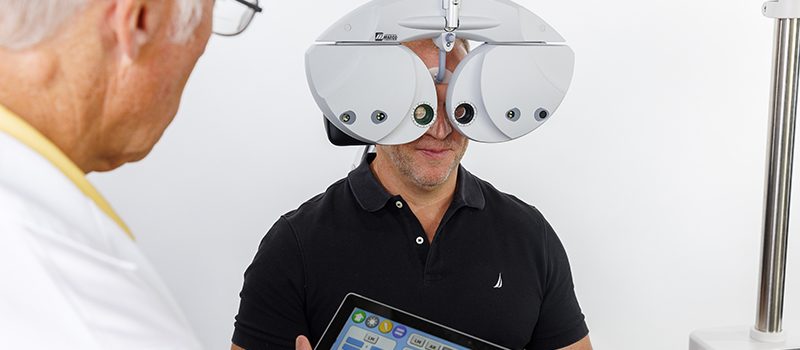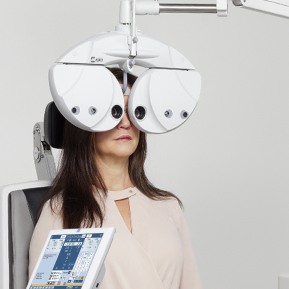
Number one or number two? Better or worse? Refraction is about choices, and if you’re still turning dials, you’re missing out on the benefits of digital refraction.
Digital refraction technology has been available for nearly 30 years, but some practices still need to embrace it. So, if you’re one of the stragglers or are interested in upgrading to a cutting-edge digital phoropter, here’s your guide to the game-changing benefits.
1. Improved Patient Experience
Patient experience is a big deal, and digital refraction can improve several aspects of a typical office visit.
It can reduce patient stress.
While refractive tests are a standard check for vision errors like farsightedness, nearsightedness, and astigmatism, manually cycling through one lens at a time can be stressful for patients.
“No one likes pop quizzes,” says Chris Sarakaitis, Director of Sales, Eastern USA for Marco. “For many patients, manual refraction causes anxiety during and after the exam when they think back and worry if they made the appropriate choices.”
Digital refractors allow the patient to see two images simultaneously, eliminating the back and forth of manual devices and enabling patients to feel more confident about their responses.
Happy patients generate revenue.
A pleasant, comfortable experience can not only decide whether someone schedules another appointment with your practice, but it also influences how much money patients spend during those visits.
“The Marco TRS Automated Refraction System has proven to be the most significant addition ever made to our practice,” says Dr. Richard K. Levin of Levin Eyecare in Baltimore, MD. “The ‘wow’ factor has increased optical sales by 15% in the first year and continues to enhance the patient’s experience in our practice.”
Provide a cutting-edge experience.
Thanks to smartphones, consumers have endless decision-aiding information in their hands. They want state-of-the-art care, and if you’re not offering it, it’s easy to find someone who will. Providing a high-tech experience with digital refraction will not only increase patient retention, but also referrals.
 “I’ve gotten patient referrals from other customers exclusively based on how impressed they were with my equipment,” says Dr. Andrea Knouff of Eyeclectic Vision Source in Atlanta, GA. “In today’s internet-savvy world, we must stay up to date on technology and separate ourselves from the competition.”
“I’ve gotten patient referrals from other customers exclusively based on how impressed they were with my equipment,” says Dr. Andrea Knouff of Eyeclectic Vision Source in Atlanta, GA. “In today’s internet-savvy world, we must stay up to date on technology and separate ourselves from the competition.”
2. Superior Accuracy
When technology outperforms the status quo, it’s a sound investment. For example, where traditional refraction relies on manual measurements and subjective evaluations, digital refraction uses sophisticated computer algorithms.
The result is highly accurate and precise measurements of a patient’s visual acuity, allowing optometrists to quickly and easily identify changes in a patient’s vision. This translates to more accurate diagnoses and the ability to provide more effective treatments.
“You can do more testing, more precisely and efficiently, with digital refraction versus a manual refractor,” says Sarakaitis. “Simply put, digital refraction makes you a better doctor.”
3. Reduced Human Error
While optometrists and ophthalmologists still need to interpret the data generated by their automated refraction system, digital refraction makes it easier to maintain accurate and up-to-date records of patients’ vision. This can be useful for tracking changes over time and identifying potential health problems.
During the exam, optometrists will find that digital refraction eliminates the potential for human error caused by factors such as poor lighting or difficulty reading the patient’s responses.
When the exam is complete, that data must be entered into the patient’s records. No matter how careful or well-trained your staff is, transcription errors happen. Digital phoropters eliminate human error by transferring exam data directly to the patient’s electronic medical record, saving time and resources by freeing up staff for other tasks.
4. Better User Experience for Clinicians
While stressful for the patient, turning the dials for manual refractive tests is no party for the clinician. Throughout a career, seeing several patients daily can cause a lot of wear and tear on the neck and rotator cuffs. One study determined that more than 80 percent of optometrists surveyed reported work-related discomfort in their neck, shoulder, or lower back.
Digital refractors use automated technology that consolidates those manual adjustments to the push of a button. In addition, some models — such as the Marco TRS-6100 Automated Refraction System — can be operated with one hand. As a result, physicians can remain seated or find a position that makes them comfortable, potentially reducing repetitive stress injuries.
5. See More Patients
Traditional refraction methods can be time-consuming and labor-intensive, taking up valuable time that’s better spent on other aspects of patient care. Digital refraction, on the other hand, is quick and easy to use, allowing optometrists to see more patients throughout the day while spending more quality time with each patient.
“Without this efficient technology, I would not have the same amount of time to dedicate to conversing with patients,” says Dr. Nathan Bonilla-Warford of Bright Eyes Family Vision Care in Tampa, FL. “In this day and age, patients notice new technology in the practice and like the personal focus I can give them.”

